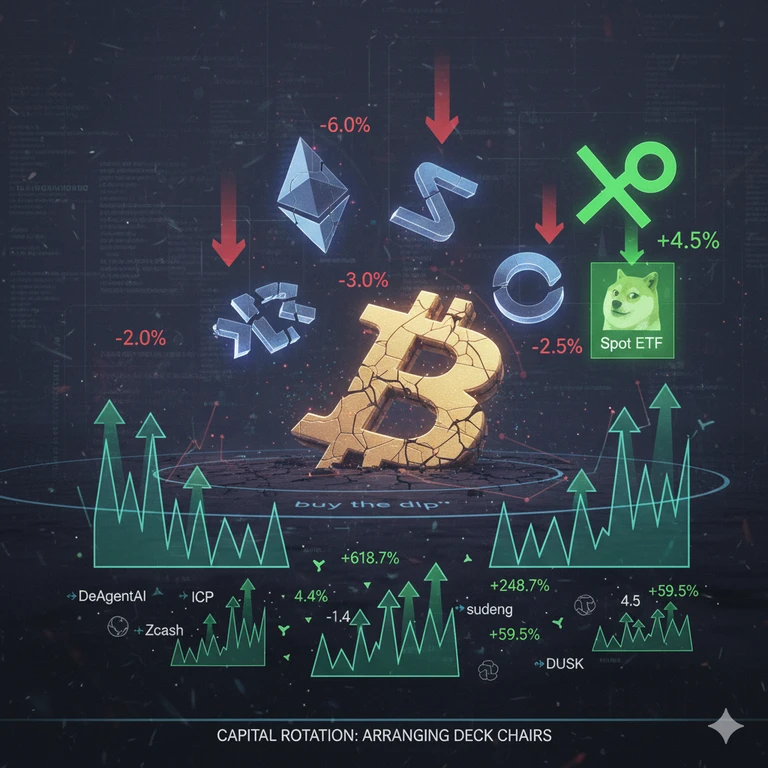Bitcoin shattered the $100,000 psychological barrier on November 5, 2025—the first time since late June—as the cryptocurrency that once promised financial revolution confronts an identity crisis. Down more than 20% from October's peak of $126,198, Bitcoin has officially entered bear-market territory, erasing nearly all gains accumulated through 2025's turbulent year.
The collapse arrives not from the leveraged speculation that characterized past crashes, but from a more ominous source: massive whale liquidations totaling $45 billion and systematic institutional withdrawal. Peter Thiel's warnings about Bitcoin's "co-option" by traditional finance—dismissed by many when delivered at the Aspen Ideas Festival—now echo with uncomfortable prescience as the PayPal co-founder's prediction of a "volatile, bumpy ride" materializes precisely as forecast.
The Whale Migration: When Giants Exit Together
Large Bitcoin holders—wallets controlling significant positions accumulated over years—are systematically exiting in coordinated waves. Bitcoin fell as much as 7.4% on November 5 to dip below $100,000, down more than 20% from its record high reached a month ago, marking a selling pattern fundamentally different from previous corrections.
Long-term holders are selling as a common feature in bull markets, but retail spot buyers have been less engaged than prior cycles, according to Compass Point analyst Ed Engel. This creates a dangerous imbalance: sophisticated players exit while the traditional buyer base—retail investors who previously purchased every dip—remains absent.
The liquidation cascade stripped $45 billion from the market in concentrated selling pressure. Total crypto liquidations topped $2.09 billion in 24 hours, mostly from long positions, as overleveraged positions collapsed. Unlike the 2022 crash driven by speculative excess, this downturn reflects fundamental demand deterioration.
Tether's response illustrates institutional nervousness. Tether's BTC reserve wallet withdrew 961 BTC worth $97.18 million from Bitfinex, likely signaling a dip-buying move. Yet even this sizable purchase—from a wallet ranking sixth globally with 87,296 BTC valued at $8.84 billion—failed to stem the decline, suggesting sellers overwhelm even major buyers.
The ETF Exodus: Institutional Enthusiasm Reverses
Spot Bitcoin ETFs, once hailed as the gateway to mainstream adoption, now function as exit ramps. Spot Bitcoin ETFs saw significant outflows of $577.7 million on November 4, indicating intensified selling pressure across institutional Bitcoin products.
The breakdown reveals concentrated institutional retreat:
Fidelity's FBTC: Led outflows with $356.6 million in single-day redemptions
Grayscale's GBTC: Shed $48.9 million as legacy holders continued exiting
Ark & 21Shares' ARKB: Recorded $128.1 million in withdrawals
BlackRock's iShares Bitcoin Trust ETF saw outflows exceeding $400 million last week and around $560 million so far this week as of November 5. BlackRock's IBIT, despite maintaining $80.2 billion in net assets and remaining the sector leader, reported zero inflows—a stark signal that even the world's largest asset manager cannot attract new capital into Bitcoin positions.
The cumulative impact is severe. The cumulative total net inflow for all US spot Bitcoin ETFs now stands at $60.42 billion, while total net assets amount to $134.53 billion, representing 6.69% of Bitcoin's market capitalization. Daily trading volume of $8.94 billion reflects active participation—but overwhelmingly in the wrong direction for bulls.
Thiel's Prophecy Fulfilled: The Co-Option Complete
PayPal and Palantir co-founder Peter Thiel predicted that Bitcoin was unlikely to see a dramatic surge, stating "I'm not sure it's going to go up that dramatically from here" during a CNBC interview in June 2024. His reasoning centered on philosophical betrayal rather than technical analysis.
Thiel felt that Bitcoin has been "co-opted" by organizations such as BlackRock, arguing that Bitcoin hasn't fulfilled its vision as a cypherpunk, crypto-anarchist and anti-establishment freedom tool, instead integrating more with traditional finance with the launch of spot ETFs.
The irony cuts deep: Bitcoin's journey from fringe digital rebellion to Wall Street product delivered precisely the adoption advocates demanded—but destroyed the scarcity value that made it compelling. Thiel's Founders Fund profited handsomely from this transition, making $1.8 billion through Bitcoin investments just before the market collapsed in 2022, then purchasing another $100 million in Bitcoin in 2023 when it traded below $30,000.

Yet Thiel himself now reduces his holdings. His critique wasn't that Bitcoin would fail, but that it would succeed in becoming ordinary—absorbed into the establishment it purported to challenge, its revolutionary potential neutered by the very acceptance its supporters craved.
The Retail Void: When Small Investors Disappear
Individual investors may not be buying the dip as much as in the past, with retail spot buyers less engaged than prior cycles, according to Compass Point's analysis. This absence represents more than temporary caution—it signals fundamental behavioral shift.
Previous Bitcoin corrections featured predictable patterns: whales sold, retail bought, prices stabilized. That flywheel has broken. "While selling from Long-term Holders is a common feature in bull markets, this leaves further downside risk if Short-term Holders capitulate further", Engel warned.
The cryptocurrency market reflects this pessimism across the board. Bitcoin trades at $101,553, down 0.2% with a $2.02 trillion market capitalization, while Ethereum fell 0.1% to $3,336. Broader indices show similar stress: total market capitalization declined 4.8% to $3.45 trillion with Bitcoin dominance rising above 60%, reflecting investors' flight to relative safety.
"Bitcoin and the broader crypto market is exhausted," said Haonan Li, founder of Ethereum-based stablecoin platform Codex. "Even with stablecoin growth, rising real-world asset volumes, and Bitcoin increasingly behaving like an institutional store of value—the market doesn't care. Bad news is very bad for crypto right now, and good news barely moves the needle".

Technical Breakdown: Support Structures Crumble
Bitcoin's RSI at 30.81 sits near oversold territory, signaling weak momentum and potential vulnerability to continued downside. More concerning: Bitcoin has fallen below its 200-day moving average for the first time in three years, a technical breakdown that historically precedes extended bear markets.
Bitcoin last failed to rise on seasonal tailwinds in October 2018. In the month that followed, Bitcoin plunged 37% in November of that year. While history rarely repeats precisely, the parallel unsettles traders: seasonal strength evaporated, technical support collapsed, and retail interest vanished—creating conditions eerily similar to 2018's brutal correction.
The weekly chart reveals sustained damage. Bitcoin continues to extend its slide as it heads for another week of losses, marking its second consecutive week in the red and its fourth down week in the past five. This persistence suggests more than profit-taking—it reflects genuine re-evaluation of Bitcoin's value proposition.

Cross-Asset Contagion: When AI Dreams Sour
Bitcoin's struggles intertwine with broader technology-stock weakness. The leading cryptocurrencies attract many of the same investors as artificial intelligence stocks, linking the two trades when one goes bad. The Nasdaq Composite dropped more than 1% with investors selling AI-linked Palantir on concerns about eye-watering valuations.
This correlation exposes Bitcoin's failure to achieve its original promise: portfolio diversification. Rather than serving as digital gold—an uncorrelated store of value insulated from traditional markets—Bitcoin has become a leveraged bet on risk appetite. When technology enthusiasm wanes, Bitcoin falls harder than the stocks it supposedly hedges against.
The government shutdown compounds uncertainty. Bitcoin briefly dipped below $100K amid the U.S. government shutdown and Fed uncertainty, demonstrating that cryptocurrency remains hostage to traditional political and economic forces rather than transcending them as originally envisioned.

The Altcoin Carnage: Selective Exceptions
While Bitcoin suffered, altcoins faced devastation. Ethereum dropped 6.0% to $3,299, Solana declined 3.0% to $156, and Cardano shed 2.5% to $0.531. The uniform decline reflects systematic risk-off positioning rather than project-specific concerns.
Notable exceptions exist: XRP climbed 4.5% to $2.22, standing out as one of the few top gainers. XRP's resilience stems from anticipated regulatory clarity—Bloomberg Senior ETF Analyst Eric Balchunas revealed that Bitwise submitted an 8(a) form for its Spot Dogecoin ETF, signaling growing institutional interest in meme coin adoption in regulated markets.
Speculative tokens showed extreme volatility. DeAgentAI surged 618.7%, Internet Computer rose 4.4%, and Zcash gained 19.5% in the past 24 hours, while sudeng jumped 248.4% and DUSK added 59.5%. These movements reflect desperate capital rotation into smaller assets rather than genuine sector strength—the financial equivalent of rearranging deck chairs.

Institutional Adoption's Bitter Irony
Bitcoin achieved what its advocates demanded: institutional acceptance, regulatory clarity through ETFs, and integration into traditional portfolio construction. This victory delivered defeat.
Thiel argued during a session at the Aspen Ideas Festival that Bitcoin has shifted away from its cypherpunk ideals, marked by privacy, decentralization, and resistance to government control. The infrastructure built to mainstream Bitcoin—custodial services, regulated exchanges, tax reporting, KYC requirements—stripped away the properties that made it valuable as an alternative system.
BlackRock's involvement epitomizes this paradox. Larry Fink, once skeptical of cryptocurrency, now oversees the world's largest Bitcoin ETF. Thiel worried whether "Larry Fink with the BlackRock ETF surrendered to the anti-ESG forces, or maybe it's more like Bitcoin's been co-opted by them. And I worry it was more the latter".
The answer increasingly appears to be co-option. Bitcoin's price now moves with BlackRock's redemption flows, Fed policy signals, and equity-market sentiment—exactly like traditional assets. It succeeded in becoming normal, losing its extraordinary characteristics in the process.

Forward Trajectories: Divergent Prophecies
Analyst predictions span an impossibly wide range, revealing fundamental disagreement about Bitcoin's nature and future:
Bearish: Peter Thiel maintains limited upside given institutional saturation and ideological compromise
Cautious: For November 2025, if BTC sustains above $102,000 the weekly bias remains constructive, with potential breakout above $113,000 extending gains toward $116,000–$118,000
Bullish: Strategy founder Michael Saylor eyes an end-of-year BTC price of $150,000 while making a case for $1 million valuation before decade's end
The dispersion itself matters more than any single forecast. Markets function when participants reach rough consensus on value. Bitcoin currently lacks that consensus—some see it as digital gold destined for $1 million, others as a speculative bubble deflating toward intrinsic value near zero.
For November, the most important swing variables are inflation data and policy expectations. A benign inflation path keeping the door open to further policy easing would ease dollar pressure and support risk. Yet this dependency on traditional macroeconomic factors underscores how thoroughly Bitcoin has integrated into—rather than disrupted—the financial system.

Lessons From History: 2018's Shadow
Bitcoin last failed to rise on seasonal tailwinds in October 2018, then plunged 37% in November of that year. The parallel conditions—weakening momentum, evaporating retail interest, and broken seasonal patterns—suggest caution warranted.
Yet conditions differ meaningfully. The 2018 crash lacked institutional infrastructure: no ETFs, no corporate treasury adoption, no clear regulatory framework. Today's market includes BlackRock, Fidelity, and regulatory clarity—factors bulls argue provide price floors absent in 2018.
Bears counter that this institutional involvement creates new risks. JPMorgan disclosed ownership of nearly 5.3 million shares of IBIT as of September 30, up 64% from the previous quarter—but institutions that bought can also sell in coordinated waves, potentially with greater impact than retail panic selling.

The Philosophical Reckoning
Bitcoin confronts an existential question: What becomes of revolutionary technology when the revolution succeeds by surrendering to the existing order?
Thiel's critique cuts deeper than price prediction. He argues Bitcoin accomplished its adoption by abandoning its purpose—becoming a tradeable commodity within the system it aimed to replace rather than the foundation of an alternative financial architecture. The cypherpunk dream died not from failure but from success: acceptance by BlackRock, integration into 401(k) allocations, and conversion into just another line item on institutional balance sheets.
"Bitcoin increasingly behaves like an institutional store of value—the market doesn't care," Li observed. Perhaps the market cares profoundly—not about Bitcoin's present behavior, but about its lost potential. The asset that promised liberation from central bank manipulation now dances to Fed policy announcements. The currency meant to bypass government oversight now depends on SEC ETF approvals.

What Comes Next
Bitcoin must sustain above $108K–$110K to maintain structure. A breakout past $116K–$118K could lift prices toward $125K–$128K, while a close below $108K might trigger correction toward $104K–$106K.
These technical levels matter less than underlying dynamics. Can Bitcoin rediscover its revolutionary purpose while maintaining institutional acceptance? Can it serve both as a rebel currency and a portfolio diversifier? Can something simultaneously challenge and integrate with the financial establishment?
The November crash suggests not easily. The crypto market's October correction erased nearly all of 2025's gains, with the sector's total market cap dropping about 20% from its record high. What returns from this correction—if anything—may look quite different from what fell.
Thiel holds Bitcoin still, though in reduced amounts. The PayPal co-founder revealed he still holds a small portion of BTC in his portfolio, reiterating his regrets for underinvesting in the asset. His position embodies the paradox: skeptical of Bitcoin's upside yet convinced enough to maintain exposure, betting that even a compromised revolution retains value.
The market now tests whether he's correct. Bitcoin's bear market isn't merely about price—it's about identity, purpose, and the question of whether financial revolution can survive its own success.

Sources
Analysis based on November 2025 cryptocurrency market data from CoinDesk, Bloomberg, CNBC, CoinMarketCap, and SoSoValue. Includes Peter Thiel commentary from CNBC and Aspen Ideas Festival, institutional ETF flow data from major issuers including BlackRock (IBIT), Fidelity (FBTC), and Grayscale (GBTC), technical analysis from Compass Point and 10x Research, and market sentiment indicators from various crypto research platforms.
Disclosure & Disclaimer
Last Updated: November 2025
The information provided in this article is for informational and educational purposes only and should not be interpreted as financial, investment, tax, legal, or accounting advice. The views expressed are solely those of the authors and contributors and do not necessarily represent the opinions or positions of any affiliated organizations, partners, or sponsors.
While every effort has been made to ensure the accuracy and reliability of the information presented, no guarantee is provided regarding its completeness, accuracy, or timeliness. Markets, regulations, and financial products evolve, and readers are encouraged to independently verify all information before making financial or investment decisions.
Neither the authors nor the publishers assume responsibility or liability for any loss, damage, or adverse outcome arising from reliance on the information contained herein. All investments involve risk, including the potential loss of principal. Past performance is not indicative of future results.
Conflict of Interest & Ownership Disclosure
At the time of publication, the authors, editors, or publishers may or may not hold financial interests or positions in any securities, assets, or financial products mentioned in this article. No statement made should be interpreted as an endorsement, recommendation, or solicitation to purchase or sell any investment or financial instrument.
Any mention of companies, financial products, or investment strategies is for illustrative or educational purposes only. Should a material financial relationship, partnership, or sponsorship exist between the publisher and a mentioned entity or product, that relationship will be explicitly disclosed within the article.
Artificial Intelligence (AI) Disclosure
This article may have been created, edited, or fact-checked with the assistance of artificial intelligence (AI) systems. While AI tools are used to enhance clarity, accuracy, and analytical depth, they can produce factual, contextual, or interpretive errors. All AI-generated or AI-assisted content is reviewed by human editors before publication, but readers should exercise their own judgment and discretion when relying on this information.
The publisher and its contributors make no warranties or representations regarding the accuracy or reliability of AI-generated analyses, forecasts, or data interpretations. Readers are strongly encouraged to consult qualified professionals before making any financial, investment, or business decisions based on AI-influenced material.
Forward-Looking Statements
This publication may include forward-looking statements that express expectations or projections about future events or outcomes. Such statements involve risks, uncertainties, and factors beyond the control of the authors or publishers. Actual results may differ materially from those anticipated. Readers should not place undue reliance on forward-looking statements.
Professional Advice Disclaimer
Nothing in this publication constitutes personalized financial, legal, or tax advice. Readers should consult licensed financial advisors, attorneys, or tax professionals to evaluate any strategy, product, or investment in light of their individual circumstances, objectives, and risk tolerance.
By accessing, reading, or relying on this article, you acknowledge that you have read, understood, and agreed to this disclosure and disclaimer in its entirety.


